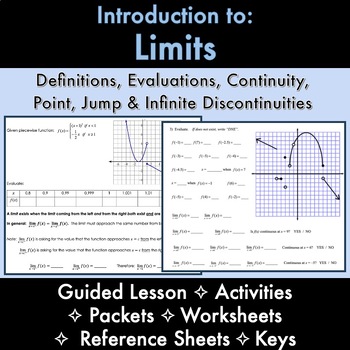Intro to Evaluate Limits & Discontinuity - Lesson, Worksheets, Activity, KEYS
- Zip
What educators are saying
Description
Calculus limits and continuity / discontinuity introductory lesson. What is a limit by definition and how does it relate to a function? How to evaluate limits at x=c and also to infinity. Students evaluate limits both algebraically and graphically, and learn what it means to be continuous at x=c and within a given interval. When do limits exist vs. not exist? Students are also introduced the definitions of each type of discontinuity, and learn how to evaluate a limit of a jump discontinuity, as well as for point (0/0 indeterminate) and infinite/asymptotic discontinuities (vertical asymptote). What is the difference between removable and non-removable discontinuity, and how do you remove the point discontinuity in order to make a function continuous using a piecewise function? Students practice justifying their answers using limit and discontinuity definitions through countless examples.
THIS ZIP-FILE INCLUDES 40 PAGES!
-------------------------
You might also be interested in my:
✫ 9-Page PRETEST with Answers [RESEARCH-BASED]
-------------------------
INCLUDED:
➤ Step-by-step answer keys with explanations/notes to EVERYTHING!
➤ Guided Lesson Packet with Reference Sheets [6 pages]
- Students begin with a piecewise function and plot values filling in a chart to guide them in determining the definition of a limit (approaching from the left and right).
- What it means for a function to be continuous at x=c and within a given interval
- Visuals and math definitions of the different types of discontinuities (point, jump and infinite/asymptotic) with many examples
- Difference between a removable and non-removable discontinuity, and how to evaluate a limit of a point discontinuity in order to make the function continuous
➤ Activity Worksheets: "Create Your Own" where students graph the function given the following limit and discontinuity conditions
➤ FIVE worksheets chock full of examples in evaluating limits, and everything involved with continuity vs. discontinuity in functions
➤ "Making Connections" Packet [4 pages]: Students fill in the charts of each function to see the connections between graphs, equations and limits as well as finding discontinuities


